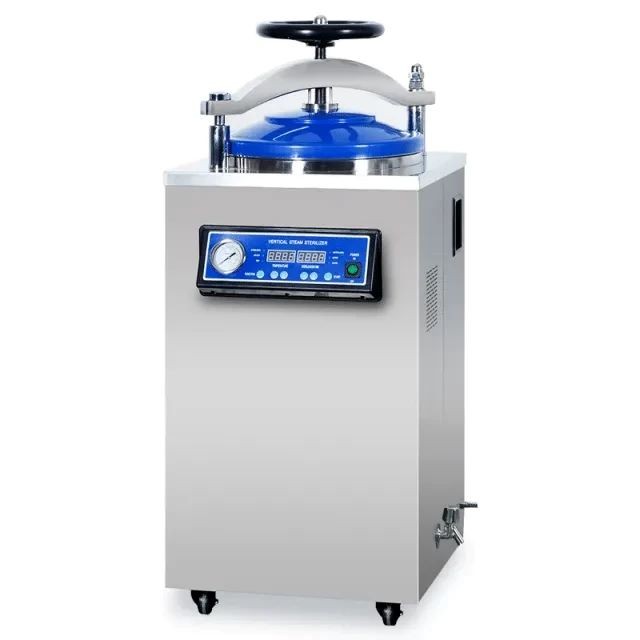
sterilization equipment
Laboratory High Pressure Steam Sterilizer Vertical Autoclave for Lab Department
Item Number : KT-P03
Price varies based on specs and customizations
- Work pressure
- 0.22MPa
- Operating temperature
- 134 ℃
Shipping:
Contact us to get shipping details Enjoy On-time Dispatch Guarantee.
Why Choose Us
Easy ordering process, quality products, and dedicated support for your business success.
Introduction
Vertical pressure steam sterilizer is a kind of automatic control sterilization equipment, which is composed of heating system, microcomputer control system and overheating and overpressure protection system. The container has the advantages of good sterilization effect, convenient operation, power saving, durability, and low product cost, and is more suitable for scientific research units and medical institutions.
Detail & Parts
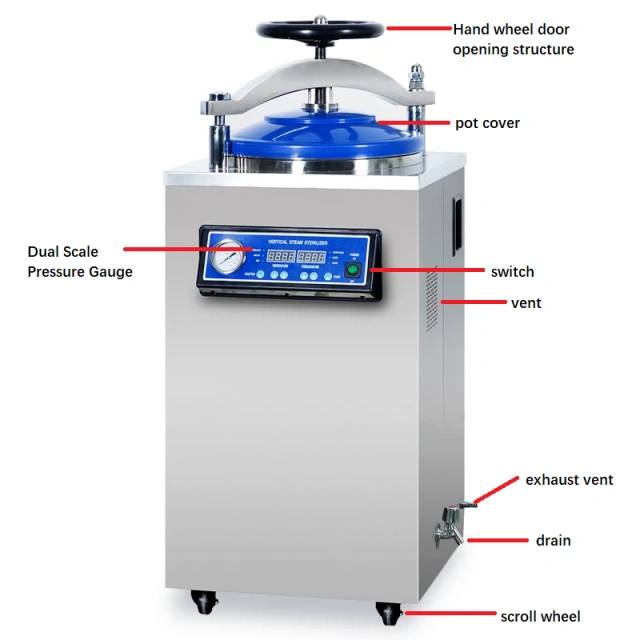
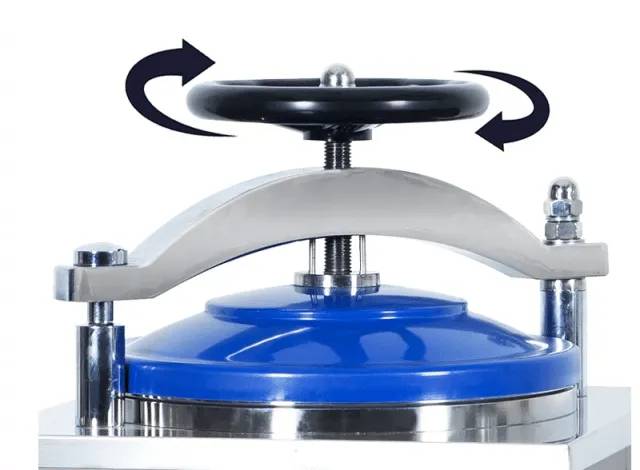
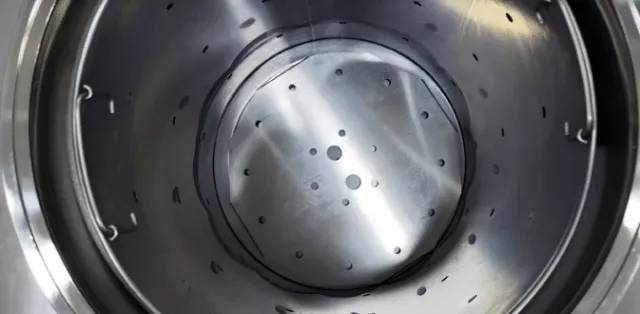
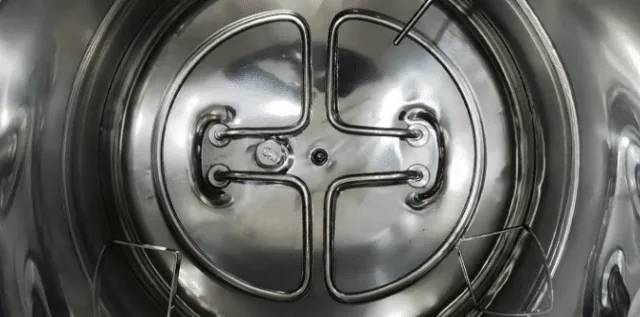
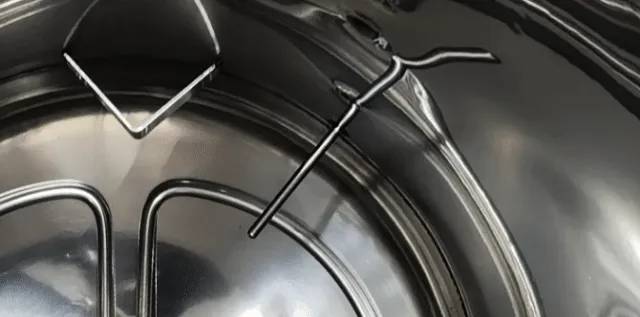


Performance and Features
- All stainless steel material
- Handwheel translation type quick opening structure
- Interlock
- There are equipment sterilization procedures, dressing sterilization procedures, liquid sterilization procedures, and custom procedures, so that different types of items can be sterilized with suitable working temperatures.
- LCD display working status, touch buttons
- Over-temperature, over-pressure automatic protection function
- The steam-water internal circulation system is equipped with an exhaust cooling system, which can avoid the generation of aerosols, does not emit steam, and the environment is clean and dry.
- self-expanding seal
- Water cut protection control
- Buzzer reminds automatic shutdown after sterilization
- Equipped with stainless steel inner barrel or double mesh basket
- Additional filters are added to exhaust steam to ensure the biological safety of the environment and operators
- Optional drying system
Specifications
| Model | KT-35HG | KT-50HG | KT-75HG | KT-100HG |
| Sterilization chamber volume | 35L φ318×450mm | 50L φ340×550mm | 75L φ400×600mm | 100L φ440×650mm |
| Fixed work stress | 0.22Mpa | |||
| Rated working temperature | 134℃ | |||
| Work Pressure | 0.23Mpa | |||
| Thermal Uniformity | ≤±1℃ | |||
| Timing Selection Range | 0-99min/0-99hour59min | |||
| Temperature Selection Range | 0-134℃ | |||
| Power/supply voltage | 2.5KW/AC220V 50HZ | 3KW/AC220V 50HZ | 4.5KW/AC220V 50HZ | |
| Dimensions (mm) | 600×410×1030 | 650×410×1140 | 690×470×1140 | 730×510×1270 |
| Transport Volume (mm) | 730×500×1170 | 730×500×1290 | 760×550×1290 | 820×600×1380 |
| Gross weight/net weight | 96Kg/77Kg | 102Kg/83Kg | 120Kg/98Kg | 135Kg/110Kg |
Designed for You
KinTek provide deep custom made service and equipment to worldwide customers, our specialized teamwork and rich experienced engineers are capable to undertake the custom tailoring hardware and software equipment requirements, and help our customer to build up the exclusive and personalized equipment and solution!
Would you please drop your ideas to us, our engineers are ready for you now!
FAQ
What Is A Steam Sterilizer?
What Are Some Common Applications Of Sterilization Autoclaves?
What Is An Autoclave Sterilizer?
How Does A Steam Sterilizer Work?
How Long Does A Typical Sterilization Autoclave Cycle Take?
How Does An Autoclave Sterilizer Work?
What Are Some Common Applications Of Steam Sterilizers?
Can Autoclave Sterilization Be Validated For Effectiveness?
What Are The Advantages Of Using Autoclave Sterilizers?
How Long Does A Typical Steam Sterilizer Cycle Take?
Can Autoclave Sterilization Damage Certain Materials?
What Safety Precautions Should Be Taken When Using Autoclave Sterilizers?
Can Steam Sterilization Be Validated For Effectiveness?
How Should Autoclave Sterilization Be Monitored And Documented?
Can All Materials And Items Be Sterilized Using Autoclave Sterilizers?
Can Steam Sterilization Damage Certain Materials?
Are There Different Types Of Autoclave Sterilizers Available?
4.9 / 5
This vertical pressure steam sterilizer is a life-saver in our lab! It's so easy to use and maintain, and it consistently delivers excellent sterilization results.
4.8 / 5
We've been using this sterilizer for a few months now and it's been a great investment. It's very efficient and effective, and it's also very easy to operate.
4.7 / 5
I'm really impressed with the quality of this sterilizer. It's made of durable materials and it's built to last. I'm confident that it will provide us with years of reliable service.
4.6 / 5
This sterilizer is a great value for the price. It's affordable and it doesn't compromise on quality. I'm very happy with my purchase.
4.9 / 5
The customer service from KINTEK SOLUTION is outstanding. They were very helpful in answering my questions and they even helped me troubleshoot a minor issue I had with the sterilizer.
4.8 / 5
I'm so glad I chose this sterilizer. It's the perfect size for my lab and it's very easy to use. I would definitely recommend it to other labs.
4.7 / 5
This sterilizer is a great addition to our lab. It's very efficient and it saves us a lot of time. I'm very happy with it.
4.6 / 5
I'm very impressed with the performance of this sterilizer. It's very effective and it consistently delivers excellent results.
4.9 / 5
The sterilizer is very easy to use and maintain. I'm very happy with the overall performance of this product.
4.8 / 5
This sterilizer is a great investment for any lab. It's very efficient and it saves us a lot of time and money.
4.7 / 5
I'm very happy with the quality of this sterilizer. It's made of durable materials and it's built to last.
4.6 / 5
This sterilizer is a great value for the price. It's affordable and it doesn't compromise on quality.
4.9 / 5
The customer service from KINTEK SOLUTION is outstanding. They were very helpful in answering my questions and they even helped me troubleshoot a minor issue I had with the sterilizer.
4.8 / 5
I'm so glad I chose this sterilizer. It's the perfect size for my lab and it's very easy to use. I would definitely recommend it to other labs.
REQUEST A QUOTE
Our professional team will reply to you within one business day. Please feel free to contact us!
Related Products
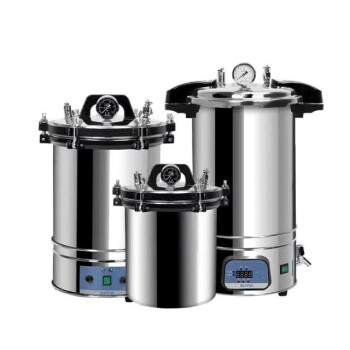
Portable High Pressure Laboratory Autoclave Steam Sterilizer for Lab Use
Portable autoclave sterilization pressure is a device that uses pressure saturated steam to quickly and effectively sterilize items.

Laboratory Sterilizer Lab Autoclave Vertical Pressure Steam Sterilizer for Liquid Crystal Display Automatic Type
Liquid crystal display automatic vertical sterilizer is a safe, reliable and automatic control sterilization equipment, which is composed of heating system, microcomputer control system and overheating and overvoltage protection system.

Mini SS High Pressure Autoclave Reactor for Laboratory Use
Mini SS High Pressure Reactor - Ideal for medicine, chemical, and scientific research industries. Programmed heating temp and stirring speed, up to 22Mpa pressure.

Stainless High Pressure Autoclave Reactor Laboratory Pressure Reactor
Discover the versatility of Stainless High Pressure Reactor - a safe and reliable solution for direct and indirect heating. Built with stainless steel, it can withstand high temperatures and pressures. Learn more now.

Laboratory High Pressure Horizontal Autoclave Steam Sterilizer for Lab Use
The horizontal autoclave steam sterilizer adopts the gravity displacement method to remove the cold air in the inner chamber, so that the inner steam and cold air content is less, and the sterilization is more reliable.

Laboratory Sterilizer Lab Autoclave Pulse Vacuum Lifting Sterilizer
The pulse vacuum lifting sterilizer is a state-of-the-art equipment for efficient and precise sterilization. It uses pulsating vacuum technology, customizable cycles, and a user-friendly design for easy operation and safety.

Laboratory Sterilizer Lab Autoclave Pulsating Vacuum Desktop Steam Sterilizer
The pulsating vacuum desktop steam sterilizer is a compact and reliable device used for rapid sterilization of medical, pharmaceutical, and research items.

Laboratory Sterilizer Lab Autoclave Herbal Powder Sterilization Machine for Plant
The herbal powder sterilization autoclave machine for Chinese medicine uses saturated steam for effective sterilization. It utilizes the heat and penetrative properties of steam, achieves sterilization after heat preservation, and maintains a good drying effect with a dedicated drying system.

Portable Digital Display Automatic Laboratory Sterilizer Lab Autoclave for Sterilization Pressure
Portable autoclave sterilization pressure is a device that uses pressure saturated steam to quickly and effectively sterilize items.

High Pressure Laboratory Autoclave Reactor for Hydrothermal Synthesis
Discover the applications of Hydrothermal Synthesis Reactor - a small, corrosion-resistant reactor for chemical labs. Achieve rapid digestion of insoluble substances in a safe and reliable way. Learn more now.

Desktop Fast Laboratory Autoclave Sterilizer 20L 24L for Lab Use
The desktop fast steam sterilizer is a compact and reliable device used for rapid sterilization of medical, pharmaceutical, and research items.

Desktop Fast High Pressure Laboratory Autoclave Sterilizer 16L 24L for Lab Use
The desktop fast steam sterilizer is a compact and reliable device used for rapid sterilization of medical, pharmaceutical, and research items.

Laboratory Horizontal Autoclave Steam Sterilizer Lab Microcomputer Sterilizer
The horizontal autoclave steam sterilizer adopts the method of gravity displacement to remove the cold air in the inner chamber, so that the content of steam cold air in the inner chamber is less, and the sterilization is more reliable.

Desktop Fast Laboratory Autoclave Sterilizer 35L 50L 90L for Lab Use
The desktop fast steam sterilizer is a compact and reliable device used for rapid sterilization of medical, pharmaceutical, and research items. It efficiently sterilizes surgical instruments, glassware, medicines, and resistant materials, making it suitable for various applications.

Customizable High Pressure Reactors for Advanced Scientific and Industrial Applications
This laboratory-scale high-pressure reactor is a high-performance autoclave engineered for precision and safety in demanding research and development environments.

Warm Isostatic Press WIP Workstation 300Mpa for High Pressure Applications
Discover Warm Isostatic Pressing (WIP) - A cutting-edge technology that enables uniform pressure to shape and press powdered products at a precise temperature. Ideal for complex parts and components in manufacturing.

Electric Split Lab Cold Isostatic Press CIP Machine for Cold Isostatic Pressing
Split cold isostatic presses are capable of providing higher pressures, making them suitable for testing applications that require high pressure levels.

High Pressure Laboratory Vacuum Tube Furnace Quartz Tubular Furnace
KT-PTF High Pressure Tube Furnace: Compact split tube furnace with strong positive pressure resistance. Working temp up to 1100°C and pressure up to 15Mpa. Also works under controller atmosphere or high vacuum.

Anti-Cracking Press Mold for Lab Use
The anti-cracking press mold is a specialized equipment designed for molding various shapes and sizes of film using high pressure and electric heating.
Related Articles

The Thermodynamics of a Perfect Seal: A Component-Level Approach to Sterilization
Learn why autoclaving your entire electrolytic cell destroys the seal. A guide to understanding material properties and protecting your experiments.

Comparing the Features of Laboratory Waterbaths: A Guide to Finding the Right Waterbath for Your Needs
Water bath is a common piece of laboratory equipment that is used to heat samples or substances to a specific temperature.

What Is Multiple Effect Evaporator?
A multiple-effect evaporator, as defined in chemical engineering, is an apparatus for efficiently using the heat from steam to evaporate water.

Comprehensive Overview of Warm Isostatic Press and Its Applications
Warm isostatic pressing (WIP) is a variant of cold isostatic pressing (CIP) that includes a heating element. It employs warm water or a similar medium to apply uniform pressure to powdered products from all directions. WIP is a cutting-edge technology that enables isostatic pressing at a temperature that does not exceed the boiling point of the liquid medium.

Enhancing Safety in Your Laboratory: A Comprehensive Guide to Pressure Reactor Safety
Laboratory safety isn't just about you. Improper preparation and mishandling can cause potential hazards that could be disastrous if left unchecked. It is crucial to take the time to carefully prepare your pressure reactor and lab safety equipment, as even minor problems can escalate quickly when working under pressure.

How to Get the Best Deal on a Rotavapor for Your Lab
A Rotavapor is an essential laboratory equipment that is widely used in various fields such as chemistry, biology, and pharmaceuticals.

10 Essential Safety Steps for Pressure Reactor Use in Laboratories
Safety is paramount when conducting chemical reactions under pressurized conditions. It is important to carefully prepare pressure reactors and laboratory safety equipment to prevent potential hazards that, if not controlled, can have catastrophic consequences. In order to ensure the safety of using a pressure reactor, it is important to understand the specifications of the reactor. Become familiar with the chemistry of the reactor material and make sure it is chemically resistant enough to withstand the substances used in the reaction.

Understanding Isostatic Pressing: Process, Benefits, Limitations, and Applications
Isostatic pressing is a manufacturing process that offers numerous benefits and applications in various industries. It involves subjecting a material to equal pressure from all directions to achieve uniform density and shape. This method is particularly advantageous compared to other production techniques.

Hazards and Safety Precautions of Laboratory Pressure Vessels
An overview of the dangers and safety measures for pressure vessels in laboratory settings.

Basic Laboratory Culture Equipment
Overview of essential laboratory equipment for biological and microbiological research.

Laboratory Safety: Safe Use of High Voltage Equipment
Guidelines for the safe operation of high-pressure equipment in laboratories, including reactors, hydrothermal reactors, autoclaves, and gas cylinders.

Basic Laboratory Drying Equipment
Overview of various drying equipment used in laboratories, including vacuum, blast, electric heating, hot air disinfection, and infrared drying ovens.